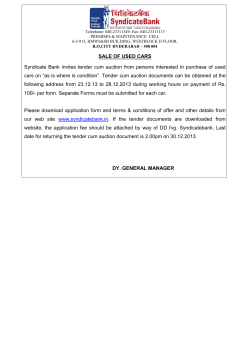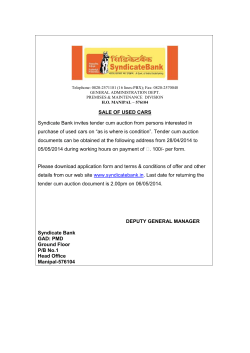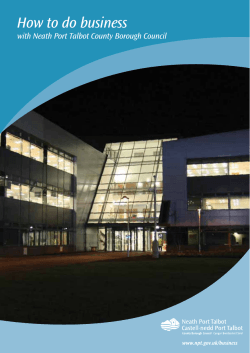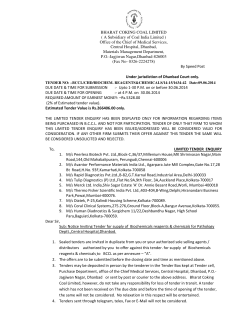
How to Prepare and Evaluate Tenders
Knowledge How To How to Prepare and Evaluate Tenders An offer, usually in writing, to execute work or supply goods or services at a stated price, and under stated conditions. CIPS members can record one CPD hour for reading a CIPS Knowledge download that displays a CIPS CPD icon. How to Prepare and Evaluate Tenders - Knowledge How To 1. Introduction Every organisation whether profit making or non-profit making, such as charities or service organisations, has a requirement for purchasing. The value of spend and the degree of sophistication can vary greatly with the nature of the product or service and with the complexity of the business itself. Today’s competitive demands require the procurement or purchasing process to be accomplished in a capable and professional manner. A contract can stand or fall on the expertise and performance of the Purchasing Manager or Buyer, who must always be striving to obtain goods and/or services at best overall value for money. Much more is involved than simply issuing requests for quotations, receiving bids and choosing the lowest as being the more appropriate. Tenders, the subject of this guide, have been a feature of good purchasing and supply management for many years, though some experts now question the wisdom of frequently inviting tenders as this conflicts with the new partnership sourcing approach. Even in longterm agreements, or partnerships, the process often starts with an invitation to tender. Before the tender stage is reached, it is essential to have a management team in place to deal with the Tender Process, thus ensuring the legalities are observed and that ownership of the process is established. This is sometimes referred to as the Procurement Project Team. It must be borne in mind that there is a risk element to the process and the team must, therefore, be knowledgeable enough to minimise that risk, accepting responsibility for it should the unforeseen occur, and be able to rectify the situation. On occasion senior management must be involved to ensure that company strategy is not compromised. If the organisation making the purchase, that is the customer organisation, has not planned the utilisation of its resources properly and does not keep up with current trends in its specific industry, if it ignores the commercial and legal aspects of setting up a contract, then the risk of failure or unplanned expenses will be greater. The number of people involved in the process and their expertise will, of course, reflect the complexity of the project in hand at any specific time. Prior to inviting tenders, the procurement organisation should have some idea as to which organisations are likely to be potentially suitable supply sources, or at least have knowledge of the contenders in the market place. This is achieved by reference to historical data on past performance of supply, and from vendor rating systems, as well as by a review of technical sources, such as magazines and company annual reports, and so on. Some organisations use simple computer programmes and databases to aid the selection of a number of likely suppliers. The disadvantage of this approach is that the systems need to be kept continuously up-to-date. Information available on such databases would probably include: • full trading name and address • product group • specific products by type • turnover and past performance, if available • any specialist knowledge or expertise • references ©CIPS 2013 1 How to Prepare and Evaluate Tenders - Knowledge How To The list can be added to as the buyer’s knowledge of the supplier is updated, probably by full Vendor Appraisal Techniques, a most useful tool in the armoury of modern purchasers. From this list the buyer can select a number of potential vendors whom he feels will be capable of meeting his requirements for quality and delivery at a reasonable cost. Care must be taken at this initial stage, otherwise truly competitive bids to the required standard may not result. Definitions Tender - an offer, usually in writing, to execute work or supply goods or services at a stated price, and under stated conditions. To Put Out to Tender or to Invite to Tender or to Request a Tender - to invite or request tenders in respect of execution of work or supply of goods and services Request/Invitation to Tender - usually, the documentation used to invite tenders; however, an invitation to tender can also be verbal. 2. Ethics Before considering the detailed stages of the tender process, the buyer should bear in mind the importance of ethics in the tender process, as this is the area where pressure may be brought to bear on the unwary buyer. The Chartered Institute of Purchasing and Supply Code of Ethics has gained wide acceptance, and provides a useful guide for the buyer. Though specifically referring to “Members” of the CIPS, the Ethical Code is an excellent guideline for staff involved in the purchasing or contractual process. One of the precepts is that both the letter and the spirit of the law should be observed in commercial transactions. This means that legal niceties should not be substituted for the basic principles of honesty and integrity. The offer and receipt of business gifts and entertainment are sensitive areas for buyers despite being widely recognised as part of traditional business practice. It is prudent to bear in mind that there is seldom any such thing as “a free meal”. A small gift is a gesture, a large gift is considered a bribe. A large number of “small” gifts can give rise to the same connotations as a “large” gift. There are many well documented cases of buyers who accepted gifts and hospitality ending up in court charged with and found guilt of corruptly accepting inducements. 3. The competitive tendering process The main objective of the tendering process is to ensure the “best fit” supplier is selected to supply goods and/or services to the customer which offers best value for money. Such a supplier is likely to be sound commercially, technically competent, financially sound and perceived as best for the task. The stages of the process are listed here and will be referred to and expanded upon as necessary. Several stages may overlap and run concurrently, depending upon complexity of the project. ©CIPS 2013 2 How to Prepare and Evaluate Tenders - Knowledge How To 3.1 Contract Strategy 3.1.1 The buyer, in consultation with all interested parties, legal, engineering, finance, production and, most importantly, the end user, should agree as early as possible the overall strategy for the project or purchase. Plans should be agreed concerning the operation of the tendering exercise, writing the detailed specification, the scope and appearance of draft tender documents, the timescales of the process and the team which will have responsibility for the evaluation of bids. 3.1.2 Account must be taken of the type of contract to be used and the timetable, the number of approved or qualified potential tenderers. If an entity is in the public sector or it is a utility subject to EU legislation, the requirements of the EU regulations and financial thresholds must be taken into account. 3.1.3 A timetable of anticipated events is essential and should be completed, at least in draft form, as early as possible to ensure target dates are achieved. Named persons with responsibility for each activity should be included to allow them time to allocate the necessary dates and times. 3.1.4 The buyer should ensure all likely requirements for the goods, or services, are identified and included in the bid process. There is nothing worse than nearing completion of one bid process only to find someone else in the enterprise has a need for the same or very similar product. A whole company business plan, if properly prepared, should remove the risk of ignoring total requirements. 3.1.5 The team should seek senior management approval for the proposed strategy before implementation. 3.1.6 The duration of any contract, particularly service contracts should be agreed at the outset. In Central Government, for instance, this is normally between three and five years, in order to ensure that the procurement organisation continues to buy in the best market, and that access to public sector contracts is open. It is a commercial decision taking into account all costs involved in the tendering process, the balance between the value of long-term contract against short-term ones and any known likely changes in the requirement for the service. 3.1.7 Further areas for the team to consider are improvements in technology, the likelihood of new contractors or suppliers entering a competitive market, price adjustments that could be foreseen, and the dangers that may arise from long-term contact with one supplier. 3.1.8 Potential conflict of interests should be considered both within the company and bid evaluation group and, in the service area, the possibility of contractors being invited to tender for conflicting or concurrent activities. 3.2 Specification 3.2.1 The specification is a most important section of the invitation to tender documentation, both for the purchasing organisation and for potential suppliers, since it is the specification which sets out precisely what characteristics are required of the products or services sought. 3.2.2 There are two main types of specification – the “functional” specification which sets out the functions that the goods and/or services are expected to fulfil, including the performance to be achieved, and the “technical” specification which stipulates the technical characteristics ©CIPS 2013 3 How to Prepare and Evaluate Tenders - Knowledge How To of the goods or services, usually designated in accordance with accepted national or international technical standards. 3.2.3 As a general rule, the specification should include expected performance or output but should not necessarily define how this should be achieved. To do so may lead to more costly solutions to the purchasing organisation’s requirements than might be proposed by potential suppliers. There is little point in specifying a Rolls Royce if a family car will do the job to the satisfaction of the customer. 3.2.4 The following is a check list of some of the aspects which, depending on the nature of the requirement, might need to be considered for inclusion in an invitation to tender: • the scope and/or functions of the work or service required • the output required • the quality expected • estimated maintenance requirements when appropriate • the number or amount • any standards required to be achieved, or applied • timescales • start date required • finish date if “time is of the essence” • a schedule of deliveries • any inspection required and at what stages • details of free issue materials • accommodation details for installation • insurance cover required for contractors • costs in use of components or complete product where appropriate • response times • details of measurement of the work 3.2.5 The following details must be included: • Interfaces – the name of the person in the purchasing organisation who will have responsibility, on behalf of that organisation, for aspects of either the tendering process, or for aspects of the management of any resulting contract, should be given. Equivalent contacts at the supplier are also required. • Resource specialisms – particularly where overseas companies are concerned, the professional qualifications of all participants should be required, and details of any standards involved, such as ISO or EN standards. Any compatibility with existing equipment, even if included in the specification, should be highlighted. • Objectives of the requirement - it can often be advantageous to alert potential suppliers to how or where precisely the requirement fits into your enterprise or process. When nearing completion of the tender process, it can be of assistance to invite tenderers to view the location or existing process. • Clarity - the prospective supplier’s role should be clearly stated, and all terminology properly defined. • Completeness – to ensure the goods or services supplied operate as expected, details of any ancillary work required for satisfactory installation and working should be given in detail. • Measurability – details of any measurable outputs should be described, as well as who will do the measurement, and the reporting process to be used. ©CIPS 2013 4 How to Prepare and Evaluate Tenders - Knowledge How To 3.2.6 Quality standards must be clearly defined to ensure there is no ambiguity, particularly between the requirements set out in the specification and information provided through any discussions or other documents. All critical aspects of the contract should be identified and it might be necessary to determine and show how they will be identified and measured. It could be that approval of a quality plan is a condition of contract and a requirement for assessment of the bids. The sort of information which might be included on a quality plan is: • the named people involved in implementing the quality plan • how the contract will be monitored, measured and reported upon • the procedures and controls in place • the quality of materials and how these are to be defined • how the service or materials will be provided • the method for resolution of difficulties or disputes • details of any improvements incorporated or proposed. 3.2.7 All documentation must clearly detail the responsibilities of the customer and supplier with respect to testing and/or acceptance of the goods or service on completion of supply. 3.2.8 In the event of a failure, by a supplier or contractor, details should be included to the effect that the customer reserves the right to employ another supplier or contractor to complete the contract, with all resulting costs becoming the responsibility of the failed contractor or supplier. 3.2.9 Use of any existing services must be detailed. Care must be taken, however, to ensure such requirements will not limit the scope or range of possible cost savings. As an example, would any training provide better value if carried out off-site rather than utilising in-company training resources? 3.2.10 When drawing up a specification and/or contract details the need for competition must be maintained. As an example, gains anticipated during the life of the project or process, or from more efficient equipment, must be considered when preparing any specification or tender where the exercise is a retendering one. 4. Requirements in the specification to be evaluated 4.1 The task of the evaluation exercise is to select the bid or tender which will give the Best Value for money at best overall cost. This will most likely result from balancing cost, quality, delivery, performance and risk. The necessary criteria used in making this decision will include technical compliance, the capacity and capability of the bidder, the quality offered and the prices/costs of alternative bids. 4.2 As a matter of good procurement practice all tenderers should be made aware of the criteria being used for the particular bid assessment. Any changes made to the evaluation process must be communicated to ALL potential bidders to ensure parity of tendering. 4.3 If “Time is of the Essence” then it must be stated. If compatibility with existing equipment is necessary then that fact must be clearly stated as a prime requirement or criteria in assessment. Where time is “the essence of the contract”, a clause which may be inserted into a contract where delay could result in consequential loss to the buyer, could include the ©CIPS 2013 5 How to Prepare and Evaluate Tenders - Knowledge How To words; “Time of Performance Shall be the Essence of This Contract”. Should delivery be delayed then Liquidated Damages clauses may be enforced. 4.4 Where there is a requirement that full shipping and demurrage costs should be included in the tender and possibly shown as a separate item, this should be stated. These costs can be considerable should the successful supplier be from overseas and if not supplied in detail may result in the bid being non-competitive when considered at bid evaluation. 4.5 It is normally desirable to state the language to be used in the tender. However, if this is not desirable, then it is recommended that detail should be included as to who will bear any translation costs should documents be in another language than that of the purchasing organisation. These costs can be heavy, particularly where a long, full technical specification is involved. Translation can also effect time scales and should be considered at the strategy stage of the tender process. 5. Communication 5.1 No bidder should be given preference, or assisted with clarification, without the same advantage being given to other tenderers. It is permissible to visit the premises of bidders as an aid to assessment of their capabilities. From the potential bidders point it may be of assistance to them if they can visit the customer’s premises to ascertain exactly how the equipment or service will be integrated into the existing procedures. This, too, is acceptable provided that only relevant detail is shown. The facility must be offered to all bidders and it is up to them to avail themselves of the facility should they wish. 5.2 It will probably be necessary to meet with bidders after their bids/tenders have been opened and assessed. This should only be for the purposes of clarification of points, and to inspect the quality methods and production methods offered in the bid documents. All findings and conversations must be accurately recorded. Should relaxation or changes in the statement of requirements or specification be offered to one bidder then the same must be communicated to all bidders. 5.3 All communications must be through recognised channels and should be via the named persons in the bid documentation. Unauthorised contact with others should not be allowed. 5.4 Parity of tendering must be observed. 6. Prequalification 6.1 Prequalification of prospective tenderers is used to ascertain that only those who meet specific criteria, and have the necessary capabilities, are considered for inclusion in a list of invitees to bid. It is a recognised means of limiting the size of a bid list should there be the likelihood of more bids than it is reasonably acceptable to handle. 6.2 Normally prequalification results from responses to a specific list of questions posed by the customer. These would relate to experience of the service or equipment, the capacity to supply, the quality available, the financial stability and competence. More recent is the environmental commitment of the company and the procedure for compliance with such legislation as the EU Packaging Directive. ©CIPS 2013 6 How to Prepare and Evaluate Tenders - Knowledge How To 6.3 Good practice is to notify all interested bidders whether or not they have been included on the shortlist. 7. Invitations to tender 7.1 Invitations to tender should normally consist of the following sections; it will however depend upon the complexity of the requirement. Part 1 - Defines the contract, giving details of timescales for commencement and completion Part 2 - Contains the “Conditions of Contract” wherein the commercial details are explained in simple language; where appropriate the draft contract can be included. Part 3 - Should be a pricing schedule Part 4 - Will give details of the scope of the work or services or the quantity and frequency of requirements of goods or services to be supplied. Part 5 - Depending on the size of the contract, should highlight all procedural requirements, such as third party inspection, variations if any, the communication route and names of people involved in discharging contractual requirements and so on. Part 6 - The specification; if a “Technical” specification this should give full details of the work, supply or service to be undertaken; current preference is for this to be a “performance” or “functional” specification, which allows freedom of choice to the bidder as to how best to meet the requirement. Part 7 - Any drawings and/or plans required to allow bidders to ensure their offered goods or service comply, not only to the specification, but also to those drawings originally issued as part of the Technical Specification. Part 8 - Should contain details of free issue goods, if any, and the arrangement for such free issue. Part 9 - Gives details of submission of bids, such as time and precise location, that late bids will not be accepted, the date of bid opening and whether it will be open or closed. Open bidding is where all bidders have the option of being present to view and note total prices submitted by all bidders. Often used overseas as a means of avoiding accusations of corrupt practices as only those bids opened, registered, and with their total cost announced, will be considered in the evaluation process. Where appropriate, information should be included on the tender evaluation methods that should be adopted. Part 10 - Will detail the terms and conditions anticipated in any resultant contract, so that bidders may take any “special” conditions into consideration when compiling their tender. All invitations to tender for a specific product or service must be identical on issue. 8. Invitations to tender 8.1 It is normal procedure to conduct invitations to tender under the sealed bid process. In this, every bid must be submitted sealed and only opened at the due time, on the due date, ©CIPS 2013 7 How to Prepare and Evaluate Tenders - Knowledge How To which has been notified in the Invitation to Tender. Tenders must be submitted by that date at the latest. 8.2 Bidders must describe in full how they will fulfil the requirements of the purchasing organisation, with details of delivery and payments. 8.3 The bid must also include a signed confidentiality agreement that there has been no collusion between themselves and other bidders (a bidding ring), and that there has been no improper contacts or discussions with any of the customer’s staff. It would be advisable to also contain details of insurance cover for all requirements, for the safe completion of any contract which may be confirmed. 9. Tender opening 9.1 The Tender Board can be a standing group. It might consist of a board member as chairman, the purchasing director, probably a technical expert, and a non-aligned person to act as secretary. 9.2 To ensure equality of treatment of all tenders, the Tender Board meets on the nominated day, at the nominated time, in a location suitable to accommodate all interested parties, if a public opening. If not, in a closed office. All bids are date and time stamped and recorded, with total costs noted. 9.3 Late tenders or bids should preferably not be opened but should be date and time stamped and returned to the bidder with a letter of explanation. It may be that in some companies ALL tenders are opened and those which were late, annotated as such, and kept separate from valid bids, submitted within the timescale stipulated. 10. Tender evaluation 10.1 The bid analysis team, as identified in the introduction to this guide (as the Procurement Project Team), have now to assess all components of all bids. Firstly to ensure the bid is compliant, and that all parts are complete, then to compare and assess all parts, to identify the best value for money bid overall. It is most important to ensure that the necessary skills are included in the team. For example, a financial expert, a technical expert, a purchasing expert and, if necessary, a commercial or legal expert. The process must follow a defined pattern to which all participants subscribe, to ensure all bids are dealt with in exactly the same way. The methods for comparison have to be fair, thorough and demonstrably so, should inspection take place. 10.2 The Financial Assessment should ensure that: • all costs are properly covered in the prices offered • bids are comparable that is, that currency conversions are correct at that time • any price escalation formulae are correct and cover the effect these might have during the life of the bid or resultant contract • alternative costings for alternative methods of meeting the specification are identified and • logged separately • the costings compare with, or are lower than, estimated costs when the project was conceived ©CIPS 2013 8 How to Prepare and Evaluate Tenders - Knowledge How To • details of any extra costs are identified in the bid. Examples are delivery and shipping costs, customs charges, insurance, documentation, and any testing and inspection charges • discounts are offered where appropriate • retentions’ are properly identified • terms of payment are included • costs of spares are included in the offer This list is necessarily not complete, but gives an indication of the type of cost make-up that should be considered. Should all bids exceed the estimated cost, decisions have to be made as to whether to continue and reappraise the estimate, or to abandon and recommence the whole exercise. There are, of course, variations that may be considered, such as reducing the size or the quality, or otherwise reducing the specification. If this is acceptable, then all bidders need to be alerted to allow them to rebid, if desired. Alternatively, it may be necessary to enter negotiations with the two or three lowest bids, in an effort to reduce costs to meet the estimate. Care needs to be taken here to ensure that the requirements are not so altered as to be susceptible to the accusation, by unsuccessful tenderers, that the requirement has changed so much, that they could have put in a bid on an entirely different basis. 10.3 The Technical Assessment - this should be carried out by the technical members of the group, but in association with others, when cost alternatives are offered. If a detailed specification was issued for a particular reason, then every detail must be closely checked to make sure it conforms with the original. If, however, a functional specification was issued, then the checks should be limited to ensuring the equipment or service offered will meet the requirements of the end-user. Any modifications or alternatives offered must be assessed individually, and whether any one is more cost effective than another. This again will have to be confirmed with the rest of the team, prior to positive decisions being reached. Where necessary, it is permissible to check with the bidder to ascertain that the production capacity or manpower claimed is in fact available. This is probably best done by visiting the bidders’ premises and carrying out a physical inspection. Care must be taken where the tender invitation stipulates that any spares included in the offer must meet stated requirements, and that the cost quoted for spares is compatible with the main bid. It is not unknown for spares’ costs to be quoted at inflated rates to compensate for tight pricing on the main element of a bid. 10.4 The Capacity Assessment - closely linked with the Technical Assessment, and often taken as part of it, is to check all aspects of the bidders’ capability to perform according to the contract. This may include deeper inspection of financial viability, to ascertain if they can purchase the necessary raw materials, in the first place, or if they are likely to seek financial assistance “up front”. This is not unknown in some industries where the cost of raw materials is a large part of the bid. In such cases, it will be necessary to negotiate very precisely the terms and conditions at the time of letting any contract. Where the procurement organisation is expected to put money up front to finance initial provision of materials, comparisons of offers on a DCF basis will illustrate the respective effects of different offers on the procurement organisation’s cash flow. ©CIPS 2013 9 How to Prepare and Evaluate Tenders - Knowledge How To The Assessment Group should be aware of any additional costs which may occur as a result of their decision as to whether to accept or reject a particular bid. For example: • will there be a cost resulting from loss of economy of scale (it may of course improve)? • if the offer is for the provision of services, are the resultant staff savings or reduction (or increase) in support services fully accounted for, including any costs arising from the requirements of relevant employment legislation? • have any redundancy costs been fully assessed and included in the benefits assessment? • if offers for the provision of services are being assessed, have the costs of any long-term agreement, such as those for telecommunications installation and copier rental or items which may no longer be required, been included? 10.5 It is important that throughout the assessment process transparency is maintained and seen to be maintained. A clear and documented audit trail must be provided. All decisions, and the reasons for them, should be clearly documented, signed by the responsible parties, and filed with the bid documents. Any clarification sought during the process must be recorded, as must any change to specification, or terms and conditions. As noted above, major changes must be notified to all bidders, with equal opportunity being given to all to amend their bids, if they wish. 11. Decision of the review panel 11.1 Having agreed which tender provides best overall value for money, taking into account price, quality, timing, and costs in use where appropriate, a decision can be taken about the award of the contract 11.2 Most organisations will have established procedures, including levels of delegated authority, usually on a defined financial limit basis, under which managers at different levels may take decisions on award of contracts. 11.3 Where decisions have to be referred upwards, recommendations should be put forward, detailing the factors, including price and performance, which have defined the best offer. These should be shown in comparison with the details of the nearest competing bids, where appropriate, with reasons for their rejection. A spread-sheet presentation of the competing bids is often helpful in recording the factors leading to the final recommendation or decision. 11.4 Following acceptance of the recommendation for contract award, the formal contract should be prepared. In some circumstances, post-tender negotiations can be initiated with the successful tenderer to improve details of the successful offer, such as delivery programmes, packaging and transport details. As indicated above, such negotiation must not fundamentally change the basis on which the tenders were originally requested; parity of tendering must be retained. Other points to discuss and agree at this time could be: Discounts: • negotiated and hidden • prompt payment • bulk purchase • annual order Payment Terms: • timing • how by ©CIPS 2013 10 How to Prepare and Evaluate Tenders - Knowledge How To • • • • documentation responsibilities insurance transfer of ownership Having discussed and agreed all matters relating to the bid, it is now time to write and agree the contract and its terms and conditions. Bibliography • Procurement in the Process Industry, A Lester and A Benning 1989 • Purchasing and Supply Chain Management, Kenneth Lysons and Brian Farrington (Seventh Edition) 2006 ©CIPS 2013 11 How to Prepare and Evaluate Tenders - Knowledge How To ©CIPS 2013 12
© Copyright 2025

















